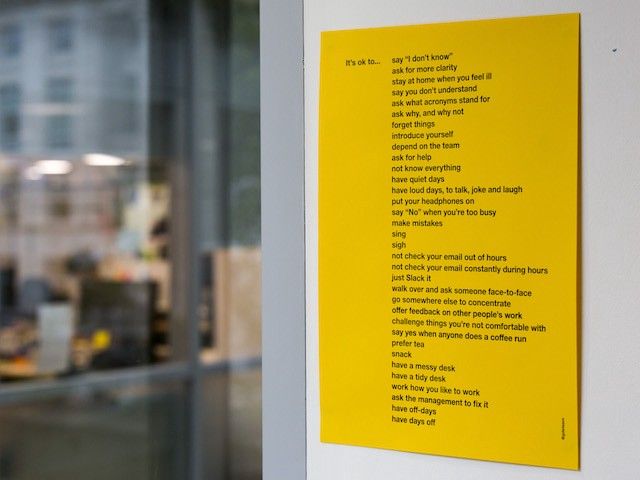

One of the great pleasures of working at Brink is the team is so varied in experience and expertise. This means I can turn around to the room of Brinksters and get advice on things like organisational psychology, agile delivery, experimentation and so much more.
We recently got together to discuss psychological safety.
What is psychological safety?
It’s something I have come across before when working in government digital teams but I was keen to find out more, particularly how to create psychological safety in newly formed teams.
When people believe that it’s okay, and in fact expected, to speak up with ideas, concerns and mistakes, then psychological safety is present.
Team members feel safe to take risks and be vulnerable in front of one another. It’s something that is only present between people, so it’s always a team construct, not something you can do by yourself.
It might feel obvious that it is a good thing, but it’s not just good for the team members. Google conducted research which found that the highest predictor of a high performing team is psychological safety. So it’s in everyone’s interest to cultivate it.
The term was coined by Harvard organisational psychologist Amy Edmondson, who talks about how psychological safety enables us to focus on learning. She says:
“every time we withhold, we rob ourselves and our colleagues of small moments of learning.”
And ultimately, vulnerability and openness to learning make it possible for us to try new things and take risks which are paramount to innovation.
Why it’s important: Shifting to a healthy listen-up & speak-up culture
Psychological safety isn’t being nice or polite to one another. It’s about having the freedom to contradict, or as this poster by UK Government Digital Service puts it: a place where “it’s ok to challenge things you’re not comfortable with”.
That day at Brink, psychological safety expert Nicole Brigandi was visiting and joined the conversation. She emphasised how feelings of fear and futility can impact human behaviour, they make us shy and unmotivated. The flip side of that is an environment where people feel courageous, inspired and safe. She described psychological safety as:
“a healthy listen-up & speak-up culture, where everyone is present in discussions.”
When the team feels safe, they’re likely to do things like propose a risky idea or admit failure publicly. They might also volunteer to do things that they don’t really know how to do or share their emotions with their teammates.
Asking employees to be vulnerable and speak out is quite a shift from historic workplace professionalism and hierarchy. But the focus on learning and the need to empower teams is totally in sync with the shift that is happening towards agile delivery, matrix management systems and more flexible work environments. All of which have proven effects on performance and delivery.
The How To’s: How you can contribute to your teams’ psychological safety
Saying that it’s okay to speak up and take risks is a start but actually creating psychological safety in teams takes more than a poster. It’s an ongoing practice that takes time and regular effort, and just like yoga, golf, or any other practice, you’ll have good days and bad days.
The idea of psychological safety as a spectrum really resonated with me. It’s not binary — safe or unsafe — but something that you build up together and can also slip back again if not maintained.

For us at Brink, it’s particularly important to think about how we can contribute to creating psychological safety in the teams we work in, where we are working across a number of boundaries (like organisational boundaries or geographic boundaries). We work on a number of different programmes, often with multiple different organisations and each group will have a different dynamic.
The good news is that everyone can contribute to cultivating psychological safety in a team.
Here are some of the little practices and nudges which we talked about that can help create an inspiring and safe work environment:
- Design meetings to encourage contributions from everyone. Set principles at the beginning of a meeting which gives everyone the right to speak regardless of seniority or status, and be sure to follow through on that throughout sessions. Be mindful of introverts and know that it’s easier for them to write their thoughts before speaking them. If you are the facilitator, specifically ask people for their views and acknowledge their contributions to make sure you are getting a diversity of perspectives.
- Give someone the role of “canary”. Harness the energy of naysayers by giving them space to speak up, raise their concerns and be heard. Like canaries in a coal mine, typically their fears are founded on real risks and listening to their divergent views will alert you to risks you may not have thought of. This is an excellent antidote to groupthink.
- Lead by example. Admit when you are wrong, ask for the team’s input, respond positively to questions or concerns and celebrate learning from failures. Be sure to listen to challenges and thank the person for their contribution, even if it is difficult to hear. By modelling the vulnerability to the rest of the team you can encourage others to do the same. If you can, aim to get the leaders in the organisation or team to do the same.
- Name it and explain why it’s so important. Whatever your role in the team, you can call out psychological safety and give it a name that’s appropriate to your context. Point to the massive and growing evidence base that the most successful and high-performing teams consistently have the ability to create psychological safety, avoid groupthink and get a diverse range of views.
- Create rituals within your team that promote openness. These should be agreed by the whole team so there is buy-in. It could be something like holding regular Retrospectives, an open forum for the team to talk about what’s working and how to improve team dynamics going forward.
These are just some of the ways that we at Brink think about creating psychological safety in our team, and the teams we work with. We’d love to hear how others are taking on this challenge. What practices do you use with your team? Get in touch in the comments below or via [email protected]
To read more about it, some of the sources we most enjoyed are:
- What Google Learnt From its Quest to Build the Perfect Team — New York Times
- High-Performing Teams Need Psychological Safety — Harvard Business Review
- Tool: Foster Psychological Safety — reWork
- HBR podcast of Amy Edmondson talking about psychological safety.





